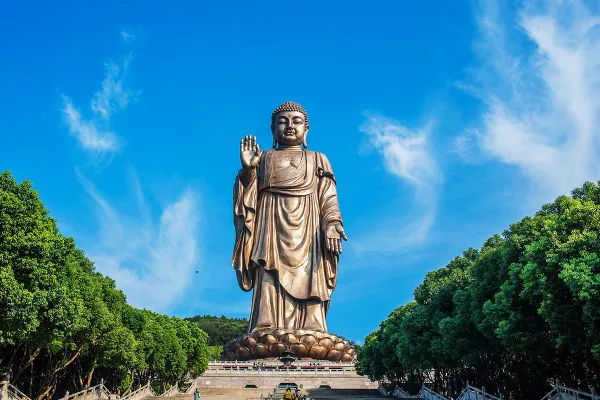
The Lingshan Grand Buddha Scenic Area is located at No. 1 Lingshan Road, Mashan Town, Binhu District, Wuxi City, Jiangsu Province. It is the core part of the Lingshan Holy Land, a national AAAAA-level tourist attraction and a iconic landmark of Wuxi. Nestled against Lingshan Mountain and facing Taihu Lake to the south, with Qinglong Mountain to the left and Baihu Mountain to the right, its prime location offers not only breathtaking natural scenery but also profound historical and cultural significance.
The history of the scenic area dates back to the Tang Dynasty over a thousand years ago. When the monk Xuanzang returned from his journey to the West to obtain Buddhist scriptures, he passed through this area and was captivated by its landscape, which resembled the Vulture Peak in India where Sakyamuni attained enlightenment. He named the area "Little Lingshan" and built the Xiangfu Temple, marking the beginning of its deep connection with Buddhism. In 1994, Zhao Puchu, Vice Chairman of the National Committee of the Chinese People's Political Consultative Conference and President of the Chinese Buddhist Association, proposed the grand vision of the "Five Buddhas of Five Directions." Due to its unique geographical location and rich Buddhist heritage, Wuxi Lingshan was chosen as the site for the Eastern Buddha. After more than three years of meticulous craftsmanship, the Lingshan Grand Buddha was consecrated and unveiled on November 15, 1997. Standing majestically by Taihu Lake, it became a shining gem of Eastern Buddhist culture and completed the "Five Buddhas of Five Directions" in China.
The Lingshan Grand Buddha stands 88 meters tall, with the Buddha's body measuring 79 meters and the lotus pedestal 9 meters. Including the three-tiered base, its total height reaches 101.5 meters. It is composed of 1,560 bronze plates, each 6-8 mm thick, welded together with seams totaling over 30 kilometers in length. The statue used 715 tons of bronze, making it the world's tallest outdoor bronze standing statue of Sakyamuni. Its artistic design blends the essence of traditional Buddhist sculpture with modern techniques. The Buddha's serene smile, slightly lowered eyes gazing upon the world, right hand in the Abhaya Mudra (symbolizing the dispelling of fear), and left hand in the Varada Mudra (symbolizing the granting of wishes) embody the compassionate and majestic presence of the Buddha.
The Lingshan Grand Buddha Scenic Area perfectly integrates Buddhist culture with natural beauty and historical heritage. Whether for Buddhist pilgrims seeking spiritual solace or tourists exploring culture and scenery, it offers a profound and soul-stirring journey of the spirit.
Historical Origins
The construction of the Lingshan Grand Buddha is a legendary tale of cultural heritage merging with modern craftsmanship. In 1992, the Mashan International Tourism Resort was established, and plans to rebuild the Xiangfu Temple were proposed to enrich the cultural landscape. In 1994, Zhao Puchu visited Wuxi for an inspection. Upon seeing the excellent feng shui of Mashan—facing Taihu Lake and backed by mountains—he proposed the influential "Five Buddhas of Five Directions" concept, which ignited the construction of the Lingshan Grand Buddha. On September 25 of the same year, with the approval of the Wuxi Municipal Government, the restoration of the Xiangfu Temple began, marking the start of the Lingshan Grand Buddha project.
The Buddha was named "Lingshan Grand Buddha" due to its location on Little Lingshan, named by Xuanzang in the Tang Dynasty. The artistic design was led by Nanjing artist Wu Xianlin, who combined traditional Buddhist sculpture with modern aesthetics to create a statue radiating compassion and solemnity. The casting was undertaken by the Nanjing Chenguang Group, which had experience in constructing the Hong Kong Tian Tan Buddha, while the architectural design was handled by the East China Architectural Design & Research Institute, known for designing the Shanghai Oriental Pearl Tower.
In April 1994, Zhao Puchu inspected the site of the Xiangfu Temple ruins. In May, the Jiangsu Provincial Government and the Chinese Buddhist Association approved the construction of the 88-meter Lingshan Grand Buddha on Little Lingshan behind the temple. On October 20, the foundation-laying ceremony was held, attended by nearly 50,000 devotees. On December 24, the casting contract was signed at the Diaoyutai State Guesthouse in Beijing, marking the project's official commencement.
On October 27, 1995, the main hall of the Xiangfu Temple was completed, and the abbot, Master Mingshan, was inaugurated. On May 30, 1996, the first bronze plate of the Buddha was installed, with eminent monks conducting a purification ceremony. On January 18, 1997, the Buddha's head was cast in a grand ceremony. By April 3, the main structure was completed, and on November 14, Zhao Puchu, then 93 years old, visited to inspect the preparations for the consecration. The next day, the grand consecration ceremony was held, attended by 80,000 devotees and broadcast globally by Phoenix TV. The Lingshan Holy Land, centered around the Grand Buddha, officially opened to the public, embarking on a new journey of spreading Buddhist culture and blessings.
Main Attractions
The Lingshan Grand Buddha
Standing 88 meters tall (101.5 meters including the base), the Lingshan Grand Buddha is the world's tallest outdoor bronze statue of Sakyamuni. Composed of 1,560 bronze plates and weighing 715 tons, it combines traditional Buddhist artistry with modern techniques. The Buddha's compassionate smile, gentle gaze, and hand gestures (right hand dispelling fear, left hand granting wishes) exude serenity and majesty.
Visitors can climb the 218-step "Path to the Clouds," adorned with seven giant stone carvings depicting Lingshan's history. At the top, the Lingshan Buddhist Culture Museum offers insights into Buddhism. An elevator inside the base takes visitors to the Buddha's feet, where touching or embracing the feet is considered auspicious. Circling the Buddha three times at the summit offers panoramic views of Taihu Lake, creating a sense of peace and transcendence.
The Nine Dragons Bathing Sakyamuni
This is the largest bronze musical fountain sculpture group in China, depicting the story of Sakyamuni's birth. A giant lotus blossom, supported by four guardians, slowly opens to reveal a 7.2-meter-tall golden statue of the infant Buddha. Nine dragons spray water to "bathe" the Buddha, accompanied by music and lights, symbolizing purity and enlightenment. Visitors can collect "Eight Merit Waters" for blessings after the performance.
The Lingshan Brahma Palace
Located in the square of the Lingshan Grand Buddha Scenic Area, the Nine Dragons Bathing the Buddha is the largest musical dynamic bronze sculpture group in China. It vividly depicts the birth of Sakyamuni. In the center of the square stands a huge copper lotus sculpture, supported by four robust warriors, surrounded by a white marble pool. Nine dragons and eight attendants circle the pool, each with a distinct posture.
The Five Mudras Mandala
This authentic Tibetan-style structure stands on a lake, showcasing vibrant colors and intricate details. Inside, it houses statues of the Five Dhyani Buddhas and exquisite thangka paintings. Visitors can spin prayer wheels, a Tibetan Buddhist practice, and admire the reflection of the mandala on the lake at sunset.
Travel Guide
Transportation
By Car: Navigate to "Wuxi Lingshan Holy Land." From Shanghai, take the Huning Expressway, then the Xiyi Expressway, exiting at Mashan. From Nanjing, take the Huning Expressway and exit at Yuqi. Parking is available at the south gate (small cars: ¥15/day; large vehicles: ¥20/day). Arrive before 9:00 AM on weekends/holidays to avoid crowds.
Public Transport: From Wuxi, take buses 88 or 89 (1-hour ride). Alternatively, take the Leyou Line 2 or a taxi (¥50 from Wuxi Station).
From Nearby Cities: Visitors from Shanghai or Suzhou can take a high-speed train to Wuxi Station, then transfer to a scenic area shuttle bus.
Ticket Information
General admission starts at ¥195 (discounts for children, seniors, students, etc.). Some tickets include performances or meals. Free entry is available for certain groups (e.g., seniors over 70, disabled persons, military personnel). Book online in advance for discounts and convenience.
Recommended Itinerary
Morning: Watch the Nine Dragons Bathing performance and collect "Eight Merit Waters."
Noon: Visit the Buddha's Hand Square and enjoy vegetarian cuisine.
Afternoon: Climb the Path to the Clouds, touch the Buddha's feet, and visit the Buddhist Culture Museum. Explore the Brahma Palace and watch the "Ode to Auspiciousness."
Evening: Visit the Five Mudras Mandala and enjoy the sunset.
Tips
-
Wear comfortable shoes and bring sun protection.
-
Try vegetarian meals at the Brahma Palace.
-
Capture photos from a 45-degree angle for the best shots.
-
Wheelchair rental and accessible routes are available.
-
Check performance schedules in advance.
